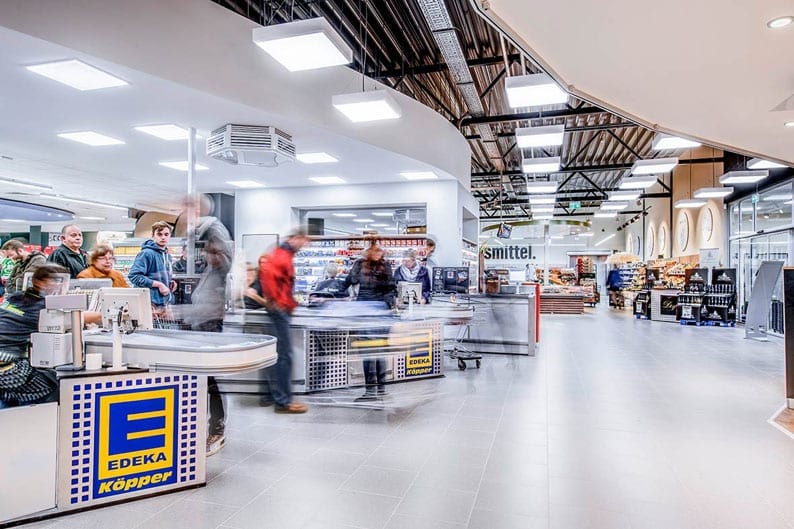
The installation of human-centric lighting has boosted sales at a German supermarket by up to 28 per cent. This article from Lux Review explains further:
The trial of the technology at an Edeka store in Lower Saxony saw total sales increase by 12 per cent compared to a nearby reference store, with confectionary sales rising by 28 per cent, fruit and vegetables by 26 per cent, wines and spirits by 23 per cent and pre-packaged meat by 23 per cent.
The scientific study, conducted over 10 months, also saw customer dwell times boosted by 21 per cent and employee absence tumble by 35 per cent.
The sensational results will provide tangible evidence to proponents of human-centric lighting can it can give clients a significant return on investment.
In the morning the lighting is a neutral-white colour temperature of 4000K with a horizontal illuminance of 700 lux. At midday and in the afternoon the colour temperature rises to a cool white 5000K and the illuminance to 1,000 lux horizontally.
Towards evening the horizontal illuminance drops to 600 lux and the colour temperature falls to a warm 3000K.
The phase shifts take place over a long period of time and are not directly perceptible for customers and employees. The progamme of changes is adapted to the seasonal course of the sun.
The settings were designed to have a positive effect on staff and customers by ‘activating’ them during the day and reducing daytime sleepiness, and ‘deactivating’ them in the evening, all using the lighting’s colour temperature and intensity.
In three waves, both employees and customers were surveyed in the two stores with regard to wellbeing, satisfaction and perception of the environment in the course of the day.
As well as the sales’ increase, the human-centric lighting had other positive effects including an improvement in sleep quality among employees. Staff who work mainly at the check-out counter at the reference store had, on average, a higher number of sickness-related days of absence in the first six months of the trial than employees in the same position at the human-centric lit store.
The number of sickness-related days of absence was reduced by more than 35 per cent given constant exposure to circadian lighting.
The influence of the human-centric lighting on the experience and behaviour of the customers was primarily determined by feedback about the atmosphere, mood and wellbeing while shopping.
The results show that the light in the human-centric lit supermarket is assessed as significantly more natural compared to the more artifocially perceived light in the reference store.
Customers appreciated the natural atmosphere of the lighting that simulates the natural course of the sun.

